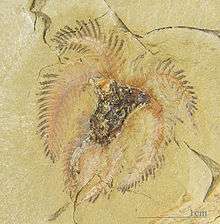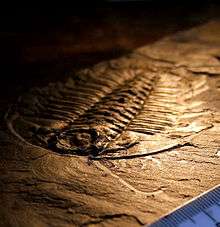Fezouata Formation
The Upper and Lower Fezouata Formations of Morocco are Burgess shale-type deposits dating to the Early Ordovician, filling an important preservational window between the common Cambrian Lagerstätten and the Late Ordovician Soom Shale.[2] Found fossilized fauna were numerous organisms previously thought to have died out after the mid-Cambrian.[3]
| Fezouata Formation Stratigraphic range: Tremadocian – Floian [1] | |
|---|---|
 Fossil of Furca, a marrellomorph from one of the exceptionally preserved intervals. | |
| Type | Geological formation |
| Underlies | Zini Formation |
| Thickness | >1,000 m (3,300 ft), combined for upper and lower formations, the two exceptionally preserved intervals ~25 m (82 ft) and 15 m (49 ft) respectively |
| Lithology | |
| Primary | Shale |
| Location | |
| Region | Drâa-Tafilalet |
| Country | |
Biota
Over 1500 non-mineralized specimens, representing 50 distinct taxa that have a composition similar to earlier Burgess Shale type biotas, have been recovered from the formations in addition to a less abundant shelly fauna.[2] The make-up of the community varies significantly through the stratigraphic sequence, with both abundances and faunal composition changing as time progresses.[2] Small (1–3 mm wide) burrows are present in the sediment, but major burrowing is absent; this may suggest a paucity of oxygen in the water or sediment.[2] Particularly notable is the presence of bryozoa and graptolites,[2] forms that are absent in the Cambrian period. Diverse echinoderms indicate a normal range of salinity, and the overall shelly assemblage is not significantly different from the normal shelly fauna expected in open Ordovician waters.[2] The non-mineralized cohort contains a range of forms familiar from the Burgess Shale: Demosponges,[4] lobopods, barnacles, annelids, anomalocaridids (e.g. Aegirocassis),[5] possible halkieriids, marrellomorphs, paleoscolecid worms, naraoiids, skaniids as well as the expected problematica. Other Ordovician oddballs are also present, including mitrates,[6] machaeridia,[7] cheloniellids and horseshoe crabs in abundance.[2]
Depositional setting
The fossiliferous strata were deposited just above storm wave base (offshore to lower shoreface transition), at between 50 and 150 metres (160 and 490 ft) water depth. Organisms were likely buried in situ.[8] Because of its placement above storm wave base, storms would have mobilized sediment that could be quickly deposited, trapping animals and leading to their preservation.[2][9] Consequently, the assemblage is dominated by benthic organisms.[2]
Preservation
Fossils of the Fezouata Formation, which are usually squashed flat (although some do retain some degree of their original three-dimensionality) are often coated with a dusting of pyrite, and tin; this aspect of the fossil preservation is very similar to that at Chengjiang.[2] Non-mineralized appendages are often preserved.[2] While the formation as a whole is over 1,000 metres (3,300 ft) thick, only two intervals, 25 metres (82 ft) and 15 metres (49 ft) thick, provide exceptional preservation.[10][11] Both of these intervals are located near the top of the lower formation, corresponding to the Araneograptus murrayi and Hunnegraptus copiosus graptolite zones respectively.[8]
Location and stratigraphy
The fossils occur within an area of 500 km2, in southeast Morocco's Draa Valley, north of Zagora. Stratigraphically productive layers are found through a 1.1 kilometres (0.68 mi)-thick column of rock that spans the Tremadocian and Floian epochs.[2] Two stratigraphic intervals of the formation are fossiliferous: the lower is Late Tremadocian and sits 260–330 m above the base of the formation; the upper, at 570–620 m, is mid-Floian in age.[1]
History
The Lagerstätten were first identified in the late 1990s when a local fossil collector, Ben Moula, showed some of the finds to a PhD student who was then working in the area.[12][13]
References
- Lefebvre, Bertrand; Gutiérrez-Marco, Juan C; Lehnert, Oliver; Martin, Emmanuel L. O; Nowak, Hendrik; Akodad, Mustapha; El Hariri, Khadija; Servais, Thomas (2017). "Age calibration of the Lower Ordovician Fezouata Lagerstätte, Morocco". Lethaia. doi:10.1111/let.12240.
- Van Roy, P.; Orr, P. J.; Botting, J. P.; Muir, L. A.; Vinther, J.; Lefebvre, B.; Hariri, K. E.; Briggs, D. E. G. (2010). "Ordovician faunas of Burgess Shale type". Nature. 465 (7295): 215–8. Bibcode:2010Natur.465..215V. doi:10.1038/nature09038. PMID 20463737.
- (BBC News) Victoria Gill, "Fossil find resolves ancient extinction mystery": accessed 13 May 2010
- Botting, J. (2007). "'Cambrian' demosponges in the Ordovician of Morocco: Insights into the early evolutionary history of sponges". Geobios. 40 (6): 737–748. doi:10.1016/j.geobios.2007.02.006.
- Van Roy, P.; Briggs, D. E. G. (2011). "A giant Ordovician anomalocaridid". Nature. 473 (7348): 510–513. Bibcode:2011Natur.473..510V. doi:10.1038/nature09920.
- Lefebvre, B.; Botting, J. (2007). "First report of the mitrate Peltocystis cornuta Thoral (Echinodermata, Stylophora) in the Lower Ordovician of central Anti-Atlas (Morocco)". Annales de Paléontologie. 93 (3): 183. doi:10.1016/j.annpal.2007.06.003.
- Vinther, J.; Van Roy, P.; Briggs, D. (2008). "Machaeridians are Palaeozoic armoured annelids". Nature. 451 (7175): 185–188. Bibcode:2008Natur.451..185V. doi:10.1038/nature06474. PMID 18185586.
- Martin, Emmanuel L.O.; Pittet, Bernard; Gutiérrez-Marco, Juan-Carlos; Vannier, Jean; El Hariri, Khadija; Lerosey-Aubril, Rudy; Masrour, Moussa; Nowak, Hendrik; Servais, Thomas; Vandenbroucke, Thijs R.A.; Van Roy, Peter; Vaucher, Romain; Lefebvre, Bertrand (2016). "The Lower Ordovician Fezouata Konservat-Lagerstätte from Morocco: Age, environment and evolutionary perspectives". Gondwana Research. 34: 274–283. Bibcode:2016GondR..34..274M. doi:10.1016/j.gr.2015.03.009. ISSN 1342-937X.
- Saleh, Farid; Candela, Yves; Harper, David A. T.; Polechová, Marika; Lefebvre, Bertrand; Pittet, Bernard. "Storm-Induced Community Dynamics in the Fezouata Biota (Lower Ordovician, Morocco)". (limited access to full article) geoscienceworld.org. Society for Sedimentary Geology PALAIOS, print edition: 21 December 2018, pp. 535-541 (Vol. 33, No. 12). Retrieved 1 March 2019.
- Saleh, Farid; Pittet, Bernard; Perrillat, Jean-Philippe; Lefebvre, Bertrand. "Orbital Control on Exceptional Fossil Preservation (abstract only)". geoscienctworld.org (subscription w/ free abstract). Geology (magazine published) 1 February 2019. Retrieved 1 March 2019.
- "Shifts in Earth's Orbit Increase the Chances of Spectacular Fossils". economist.com (Subscription for full article). The Economist, print edition: January 26th 2019, p. 72 (1/2-page based on article in Geology--in prior footnote--1/Feb/2019). Retrieved 1 March 2019.
- Van Roy, P; Lefebvre, B; El Hariri, K; Hafid, A (2008). Exceptionally Preserved Faunas from the Lower Ordovician of the Anti-Atlas, Morocco (PDF). First international Conference and Exhibition, Marrakech, Morocco.
- Jones, N. (2010). "Weird wonders lived past the Cambrian". Nature. doi:10.1038/news.2010.234.
